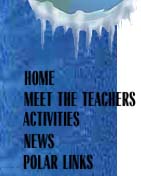
|
Sandi Kolb (1999 Orientation Presentation) I. Station Logistics A. READ the South Pole Station guidebook given to you at the arrival briefing. It contains meal schedules, housing information, safety and conservation guidelines, a station map and information on station logistics. It is very useful. B. Medical information is in the station guidebook. While at the S. Pole Station, drink 4 quarts of water per day, eat right and try to get enough rest. Some people experience symptoms of altitude sickness and frequently people catch a cold/flu while at the station. C. If you have questions, good people to ask are the dining room attendants and dishwasher (these people know the station quite well due to job rotations), the people in Comms (they know who to go to for what), the housing assistant, and the ASA science coordinator and science techs. II. Preparing to go to The South Pole Station A. Inform yourself on high altitude illness and living in extremely cold and dry conditions. B. Pack light. You will carry your own bags and will need significantly less than you believe. I took one CDC orange bag (the carry-on) half a duffel bag for 3 months. 1. Remove all packaging material including a bit of the contents and repack into double zip-lock bags (pressure/freezing) or reusable containers. Backpackers' Rule: Pack it in, pack it out. 2. Various items may or may not be available. Take your own film, batteries, floppy disks, and aluminum foil (also good for covering windows for sleeping) for wrapping them. The store sometimes runs out of stamps and personal supplies. 3. Due to extreme dryness a cold water humidifier facilitates sleeping. Take good lotion, moisturizer, and Carmex in the tube (can apply it with gloves on). Take a pocket-sized lotion for your parka. Due to close sleeping conditions and 24 hours of brightness, take plenty of earplugs and a black eye shield. 4. Wash and Dries are handy for water outages and between shower days. Because there are not enough facilities, hand sanitizer is useful prior to eating. 5. Hiking boots are comfortable for getting around the station vs. the bunny boots for longer outings. A daypack for mittens, goggles, water, camera, hardback journal, etc. helps to transport and keep track of items. 6. You will need your own towel/wash cloth. Avoid taking whites/lights due to the limit of 1 load of laundry per week. Especially at summer camp, the laundry and chlorox powders can be in unmarked containers, so be careful. The CDC does not issue sock liners. Issued socks are tube socks. If you are petite or prefer your own, take thermals (mens' style only in small, med., large). Take 1 or 2 extra neck gaiters. They get wet and the issue of one is not adequate. 7. A few light- weight gifts for the holidays, something casually nice to wear to the holiday dinners, a couple photos (loved ones, your classes, pets, home). 8. Take your prescriptions in their original containers (custom's drug control) and copies of the prescription orders just in case they need to be replaced. If you take vitamins, take your own. Many people take vitamin C and cold remedies with them. 9. DO NOT take anything to the ice you will not need there. Take an empty duffel bag to store things at the CDC for pick-up when you get off the ice. III. Professionalism A. Station life is fish-bowl living. Whether it is realized or not, TEAs will be observed and represent not only the TEA program but also teachers in general. You will be living and working with people whose children are in our schools. For those living on the ice for the summer, short-timers stand out. There is NO privacy. B. Personnel working at the station tend to work long hours and notice how many hours individuals spend in the galley, lounges and bar. They need to see by the TEA's professionalism the purpose of their job while at the station. C. Good PR is appreciated. Volunteer your turn at house-mouse duties. It is a station expectation to clean up after yourself. TEAs, like all personnel, are community members. D. Personnel can be highly educated or trained and are generally very talented. They go through a rigorous selection process and are often willing to take any job in order to have the opportunity to go to Antarctica. The dishwasher may have a Masters degree and play in a professional symphony. MBAs, PhDs and successful business owners might be vacuuming the halls, cleaning the bathrooms, working in cargo or hammering nails. The TEA's experience will be richer if friendliness is extended to everyone. Sit with a variety of personnel at meals and get to know everyone. E. The number one key to success and happiness on the ice: Be flexible. The successful TEA will also be tolerant, cooperative, and able to work well with a wide variety of people (people skills). Always practice good "expedition behavior". Back to: TEA Information Front Page |
